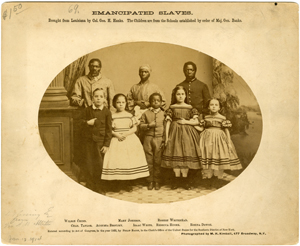
Emancipated Slaves
Slaves in Black and White: Figure 1
Subject: Emancipated Slaves
Maker: Myron H. Kimball (New York)
Genre: studio portrait
Process: albumen print
Date: 1863
Collection: New York Historical Society
This larger format photograph is the only known portrait of the entire New Orleans group, including three adults (Wilson Chinn, Mary Johnson, and Robert Whitehead) and five children (Charles Taylor, Augusta Broujey, Isaac White, Rebecca Huger, and Rosina Downs). Note that the negative has been retouched to emphasize the initials “VBM” that Chinn’s former owner, Volsey B. Marmillion branded onto his forehead. This image also tells us that Colonel George H. Hanks brought the group north for its tour and that the children come from the free schools established by General Banks for the education of emancipated slaves.Each member of this group is described in a story of January 30, 1864 in <i>Harper’s Weekly. For an analysis and bibliography, see the essay on ”White Slaves” by Celia Caust-Ellenbogen.
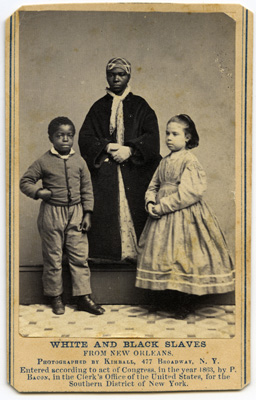
White and Black Slaves
Slaves in Black and White: Figure 2
Subject: White and Black Slaves
Maker: Myron H. Kimball (New York)
Genre: studio portrait
Process: carte de visite, albumen print
Date: 1863
Collection: Greg French
The caption to this image, “White and Black Slaves from New Orleans,” is designed to shock the (mostly white) viewers of such portraits with the realization that skin color was no obvious marker of who counted as a slave — after generations of masters forcing themselves upon enslaved women. This portrait seeks both to arouse moral outrage and prey upon the sympathy of a white audience that would identify with the “white” slave in the image. The back of the image explains that proceeds of the sale of such photographs “will be devoted exclusively to the education of colored people in the Department of the Gulf,” the region of the Confederacy around New Orleans occupied by the Union army.
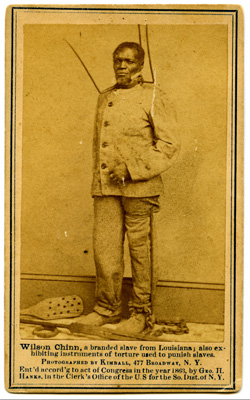
Wilson Chinn, a branded slave from Louisiana
Slaves in Black and White: Figure 3
Subject: Wilson Chinn, a branded slave from Louisiana
Maker: Myron H. Kimball (New York)
Genre: studio portrait
Process: carte de visite, albumen print
Date: 1863
Collection: Greg French
This portrait shows Wilson Chinn, branded on his forehead with the initials of his former master, Volsey B. Marmillion, and displaying implements of bondage and punishment for slaves. The device with the three prongs around his neck would prevent a person from lying down, and the rigid leg iron would prevent running to escape. The perforated paddle on the floor was for beatings. Marmillion ran a sugar plantation outside of New Orleans, and 105 of his slaves, including Chinn, escaped to the Union lines. Harper’s Weekly in a story of January 30, 1864, reported that “Thirty of them had been branded like cattle with a hot iron, four of them on the forehead, and the others on the breast or arm.”
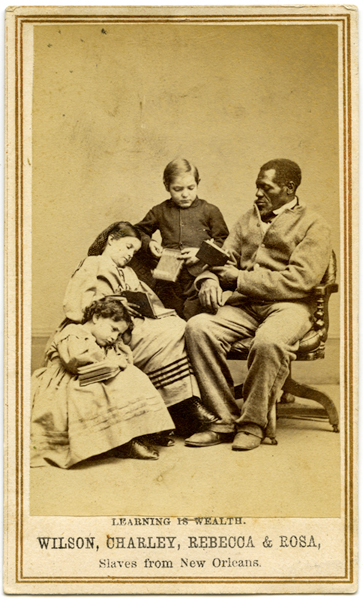
Learning is Wealth
Slaves in Black and White: Figure 4
Subject: Learning is Wealth
Maker: Charles Paxson (New York)
Genre: studio portrait
Process: carte de visite, albumen print
Date: 1863
Collection: Greg French
This image shows (from left to right) Rosina Downs, Rebecca Huger, Charles Taylor, and Wilson Chinn — all engaged in the work of learning that the series of photographs seeks to support financially through its sales. The photographer has selected the three “whitest” appearing children to sit with Wilson Chinn, who was depicted wearing chains in the previous photograph. After what must have been a very long day of posing for portraits, Rebecca and Rosina look quite exhausted.
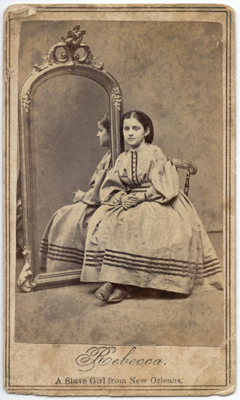
Rebecca, A Slave Girl from New Orleans
Slaves in Black and White: Figure 5
Subject: Rebecca, A Slave Girl from New Orleans
Maker: Charles Paxson (New York)
Genre: studio portrait
Process: carte de visite, albumen print
Date: 1863
Collection: John Daggett
In this portrait, Charles Paxson, the photographer, has posed Rebecca Hubner before a mirror, a common theme in portraiture of the period, especially for women. But Paxson goes beyond the conventional use of the mirror as a symbol of femininity, or even of vanity, to goad the viewer to reflect on the contradictions of slavery: that although this child might appear “white” enough to pass for white, she was nevertheless “A Slave Girl from New Orleans.” Was this merely exploitation of white self-regard to get the audience to identify with people they would not ordinarily because of their racism, or is it a legitimate attempt to shock the viewers into a realization that the racial categories were so fluid as to be meaningless?
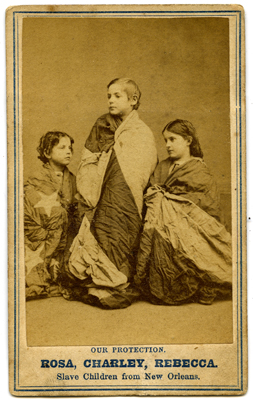
Our Protection
Slaves in Black and White: Figure 6
Subject: Our Protection
Maker: Charles Paxson (New York)
Genre: studio portrait
Process: carte de visite, albumen print
Date: 1864
Collection: Gregory Fried
Charles Paxson has selected the three “whitest” from among the “Slave Children from New Orleans” —Rosina Downs, Charles Taylor, and Rebecca Huger —to pose them literally wrapped in an enormous American flag. Paxson has titled the image “Our Protection” because the flag symbolizes both the Union army, that had taken New Orleans and given former slaves such as these the opportunity to escape bondage, and because of the foundational principles of liberty represented by the flag that Paxson and other abolitionists sought to make the goal of the war as a fight to end slavery, not just to preserve the Union. By 1863, the war exacting an enormous cost in lives and treasure, and Paxson seeks to reinforce what is worth fighting for in the conflict.
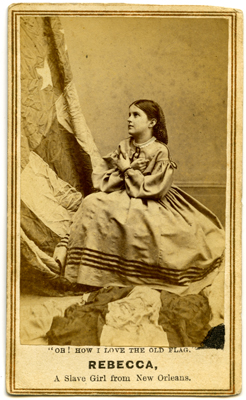
"Oh! How I Love the Old Flag."
Slaves in Black and White: Figure 7
Subject: “Oh! How I Love the Old Flag.”
Maker: Charles Paxson (New York)
Genre: studio portrait
Process: carte de visite, albumen print
Date: 1864
Collection: Joan Gage
Photographer Charles Paxson has posed Rebecca Huger before the same huge flag as in the previous image. She crosses here arms in an almost prayerful gesture that indicates both love and a sense of protection.
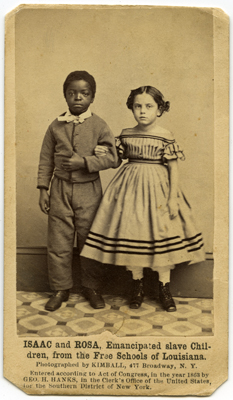
Isaac and Rosa
Slaves in Black and White: Figure 7
Subject: Isaac and Rosa
Maker: Myron H. Kimball (New York)
Genre: studio portrait
Process: carte de visite, albumen print
Date: 1863
Collection: Greg French
Isaac White and Rosina Downs pose in this portrait. The subtitle of the caption calls them “Emancipated slave Children, from the Free Schools of Louisiana,” emphasizing both the political reality of the effects of the Emancipation Proclamation of January 1, 1863 and the policy goal of educating the now free people of the occupied territory of the Confederacy. Once again, the photographer, in this case Myron H. Kimball, has sought to produce a shock by placing a matching pair of the “blackest” and the “whitest” of the children together.
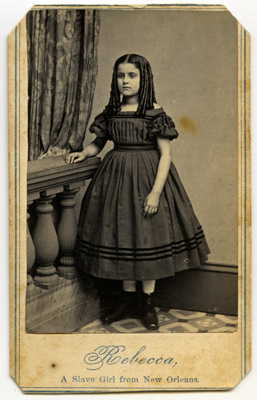
Rebecca: A Slave Girl from New Orleans
Slaves in Black and White: Figure 9
Subject: Rebecca: A Slave Girl from New Orleans
Maker: Myron H. Kimball (New York)
Genre: studio portrait
Process: carte de visite, albumen print
Date: 1863
Collection: Joan Gage
Rebecca Huger seems to have been a favorite with the photographer. Certainly she is pretty, and she also could easily have passed for white. She is also on the verge of becoming a young woman, and probably something the photographer sought to provoke for the viewer is the fate such a young woman might meet at the hands of an owner for whom an enslaved woman’s body was property to use in any way he saw fit — which would account also for the very existence of “white” slaves such as Rebecca in the first place. The publicity campaign used these photographs to uphold support for a war to end such practices.
